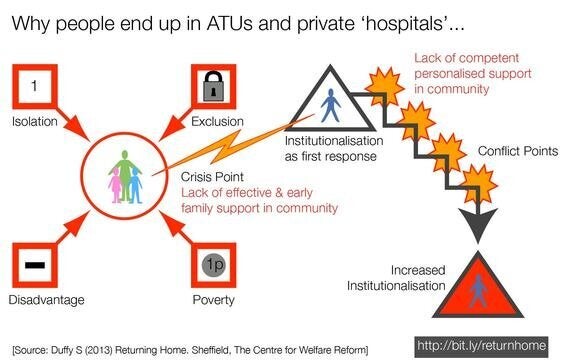Have you wondered what that strange word 'inclusion' means? Do you think about what will happen to yourself or to your family when you get older? Did your school welcome kids with disabilities or did they all go somewhere else, somewhere 'special'? Do you ever think about long-stay hospitals or asylums and what really happened behind those walls? Have you ever wondered whether it would be better if people with disabilities didn't even exist?
I suspect many readers will have given a little thought to these questions; but I don't think we like to think about these things too much. These questions rarely make the headlines and if they do the truth often seems to go missing in action.
For instance, I was recently contacted by a journalist researching the Government's intention to close what are called Assessment and Treatment Units (ATUs). His quite understandable suspicion was that this was merely an example of Government cuts; whereas I tried to explain that these services are associated with the most extreme levels of abuse and should be closed as a matter of best practice. The Government's own data shows how extreme is the level of abuse in ATUs and private hospitals. In a 3 month period:
- 25.9% had harmed themselves
- 21.0% had suffered an accident
- 22.2% had suffered physical assault
- 34.2% had been physical restrained
- 11.4% had been secluded
- 56.6% had been the subject of at least one incident of harm, seclusion or abuse
What is more we are paying £175,000 per person per year in the sure knowledge that these people will be abused. Much of this funding goes directly into the pockets of private investors and psychiatrists.
And why does this happen?
Working with families in one area I found an identical pattern of behaviour that led to abusive institutional care:
- It usually starts as the person enters adulthood. Some incident, accident or family crisis might lead a family to ask for help. But the only help on offer comes in the form of an institutional service, like a place in a residential care home.
- Then the person, already upset or frightened, gets angry at the place they'd been put. They might hurt themselves or somebody else, and so they are moved out of the 'home'.
- The person is then moved to a more institutional environment, further away from home and so the cycle begins again. Anger and fear leads to a new crisis and this leads to a new 'placement'.
- During this time the family usually finds themselves excluded from decision-making and in the end their beloved child ends up hundreds of miles from home subject to the kind of abuse I've described above.

This is a system where mostly people's 'intentions' are good. Yet at its worst this system causes the death of people like Connor Sparrowhawk, Thomas Rawnsley and so many others. At its 'best' all that is achieved is human merry-go-round of abuse, waste and frustration.
None of this is necessary.
We know how to provide people good, personalised and effective support. We know how to help people start in control of their own lives and remain active citizens - included in our communities. We know how to do better - we just don't do it.
In fact the Centre for Welfare Reform has just launched an international survey to map and measure progress in delivering personalised support for any service trying to support citizenship not segregation.
So, why don't we do better?
There are many reasons for this, but one reason is that we are all too frightened. We are frightened of ageing, of disability and our inevitable death. We prefer solutions that tidy away those people who look too different or who behave differently. Segregation and institutionalisation - despite their terrible human costs - meet a base human need: the need to avoid facing our own vulnerabilities and frailties.
Yet, if we can overcome this fear, we have so much to gain. We can live as equal citizens, contributing, loving and being loved, whatever our age, disability or illness. We can benefit from the contribution of all those who otherwise are seen as 'too different'. This is inclusion.
For instance, people with learning disabilities, can help us to understand what is really important in human life. Last year, the great thinker and innovator Jean Vanier was awarded the Templeton Prize. In his acceptance speech he said these wise words:
There is a revolution going on. We are beginning to realise that everyone, every human being is important. We are beginning to see that every human being is beautiful. At the heart of this revolution are not the powerful, the wealthy or intelligent. It is people with disabilities who are showing us what is important - love, community and the freedom to be ourselves.
It's time we all joined this revolution. It's time we put behind us all the walls and exclusions. It's time we recognised the value of every human being. It's time to build a world where everybody matters. That's what inclusion means.
